University Transport and Logistics Operations Report: CILT Level 5
VerifiedAdded on 2022/09/27
|36
|8458
|40
Report
AI Summary
This report delves into the multifaceted aspects of transport and logistics, addressing key areas such as the relationship between transport attributes and economic policy, the impact of government policies on transport provision, and the differences between regulation and deregulation in the transport sector. It examines regulatory measures for various modes of transport, current methods for preventing anti-competitive practices, and the influence of external bodies on transport policy. Furthermore, the report explores fleet management strategies, including replacement plans and cost analysis. The assignment also covers internal organizational dynamics, focusing on planning and implementing change projects, with a focus on employee involvement and effective communication. The report provides a comprehensive overview of transport operations, policy, and management, providing valuable insights for students studying logistics and transport.
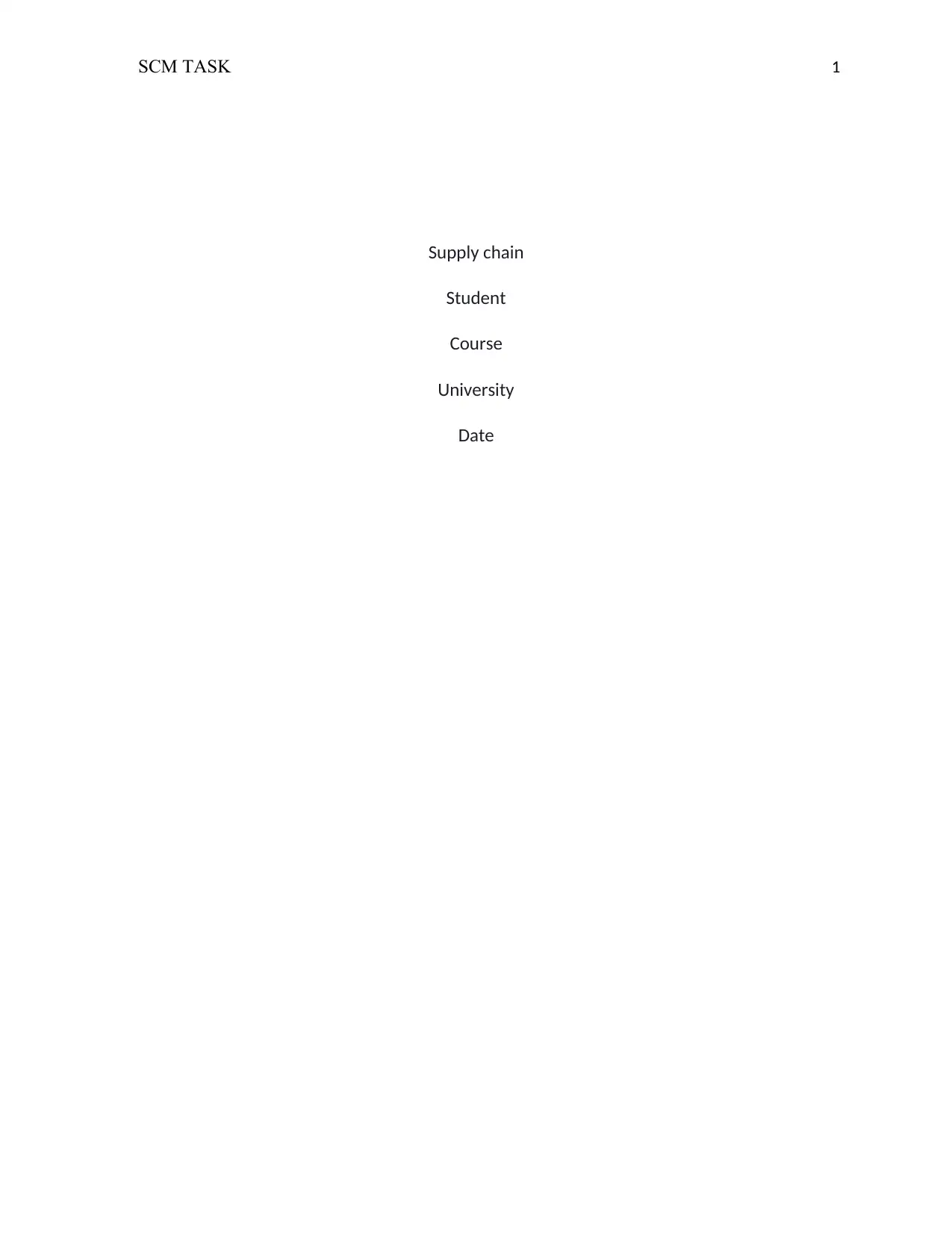
SCM TASK 1
Supply chain
Student
Course
University
Date
Supply chain
Student
Course
University
Date
Paraphrase This Document
Need a fresh take? Get an instant paraphrase of this document with our AI Paraphraser
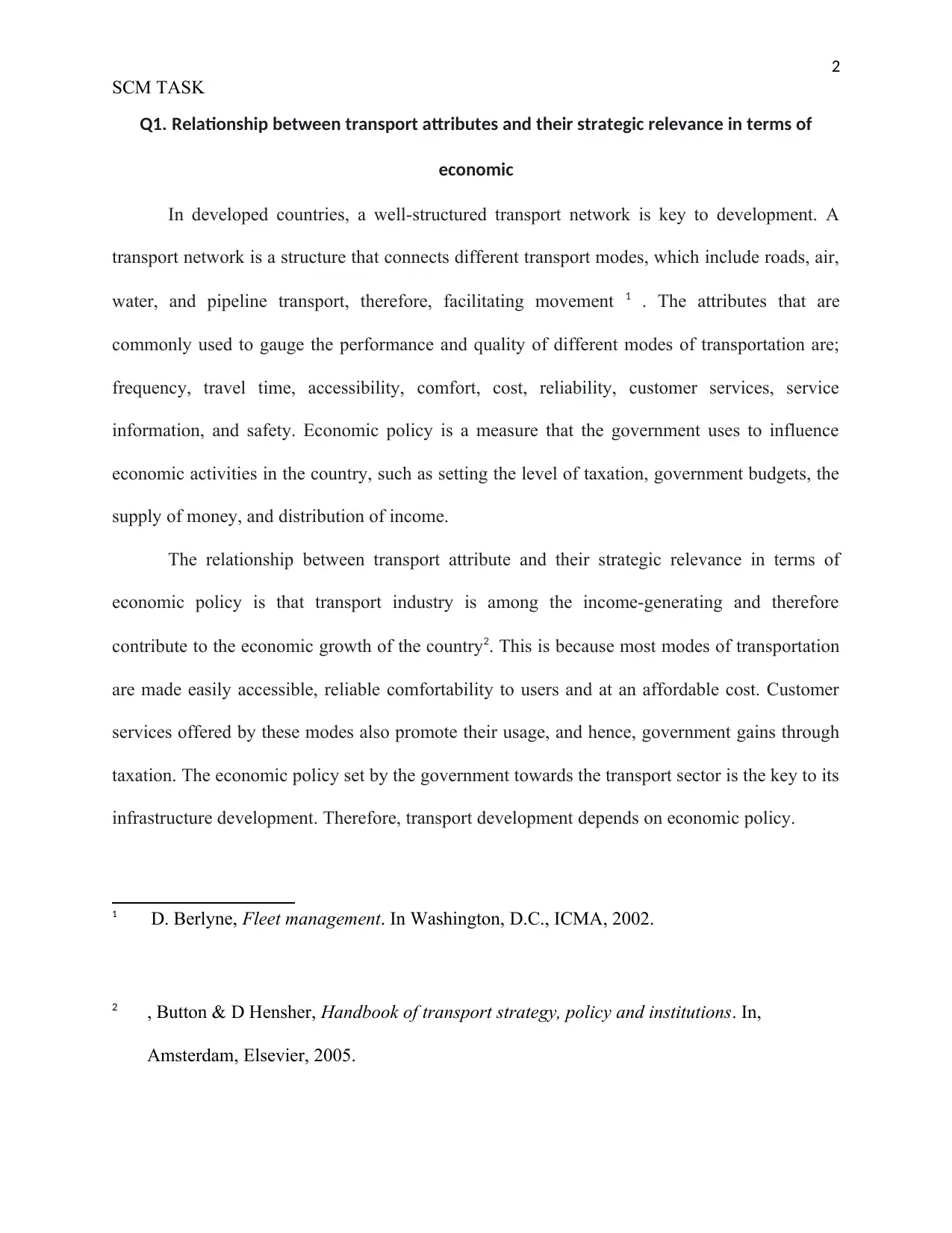
2
SCM TASK
Q1. Relationship between transport attributes and their strategic relevance in terms of
economic
In developed countries, a well-structured transport network is key to development. A
transport network is a structure that connects different transport modes, which include roads, air,
water, and pipeline transport, therefore, facilitating movement 1 . The attributes that are
commonly used to gauge the performance and quality of different modes of transportation are;
frequency, travel time, accessibility, comfort, cost, reliability, customer services, service
information, and safety. Economic policy is a measure that the government uses to influence
economic activities in the country, such as setting the level of taxation, government budgets, the
supply of money, and distribution of income.
The relationship between transport attribute and their strategic relevance in terms of
economic policy is that transport industry is among the income-generating and therefore
contribute to the economic growth of the country2. This is because most modes of transportation
are made easily accessible, reliable comfortability to users and at an affordable cost. Customer
services offered by these modes also promote their usage, and hence, government gains through
taxation. The economic policy set by the government towards the transport sector is the key to its
infrastructure development. Therefore, transport development depends on economic policy.
1 D. Berlyne, Fleet management. In Washington, D.C., ICMA, 2002.
2 , Button & D Hensher, Handbook of transport strategy, policy and institutions. In,
Amsterdam, Elsevier, 2005.
SCM TASK
Q1. Relationship between transport attributes and their strategic relevance in terms of
economic
In developed countries, a well-structured transport network is key to development. A
transport network is a structure that connects different transport modes, which include roads, air,
water, and pipeline transport, therefore, facilitating movement 1 . The attributes that are
commonly used to gauge the performance and quality of different modes of transportation are;
frequency, travel time, accessibility, comfort, cost, reliability, customer services, service
information, and safety. Economic policy is a measure that the government uses to influence
economic activities in the country, such as setting the level of taxation, government budgets, the
supply of money, and distribution of income.
The relationship between transport attribute and their strategic relevance in terms of
economic policy is that transport industry is among the income-generating and therefore
contribute to the economic growth of the country2. This is because most modes of transportation
are made easily accessible, reliable comfortability to users and at an affordable cost. Customer
services offered by these modes also promote their usage, and hence, government gains through
taxation. The economic policy set by the government towards the transport sector is the key to its
infrastructure development. Therefore, transport development depends on economic policy.
1 D. Berlyne, Fleet management. In Washington, D.C., ICMA, 2002.
2 , Button & D Hensher, Handbook of transport strategy, policy and institutions. In,
Amsterdam, Elsevier, 2005.
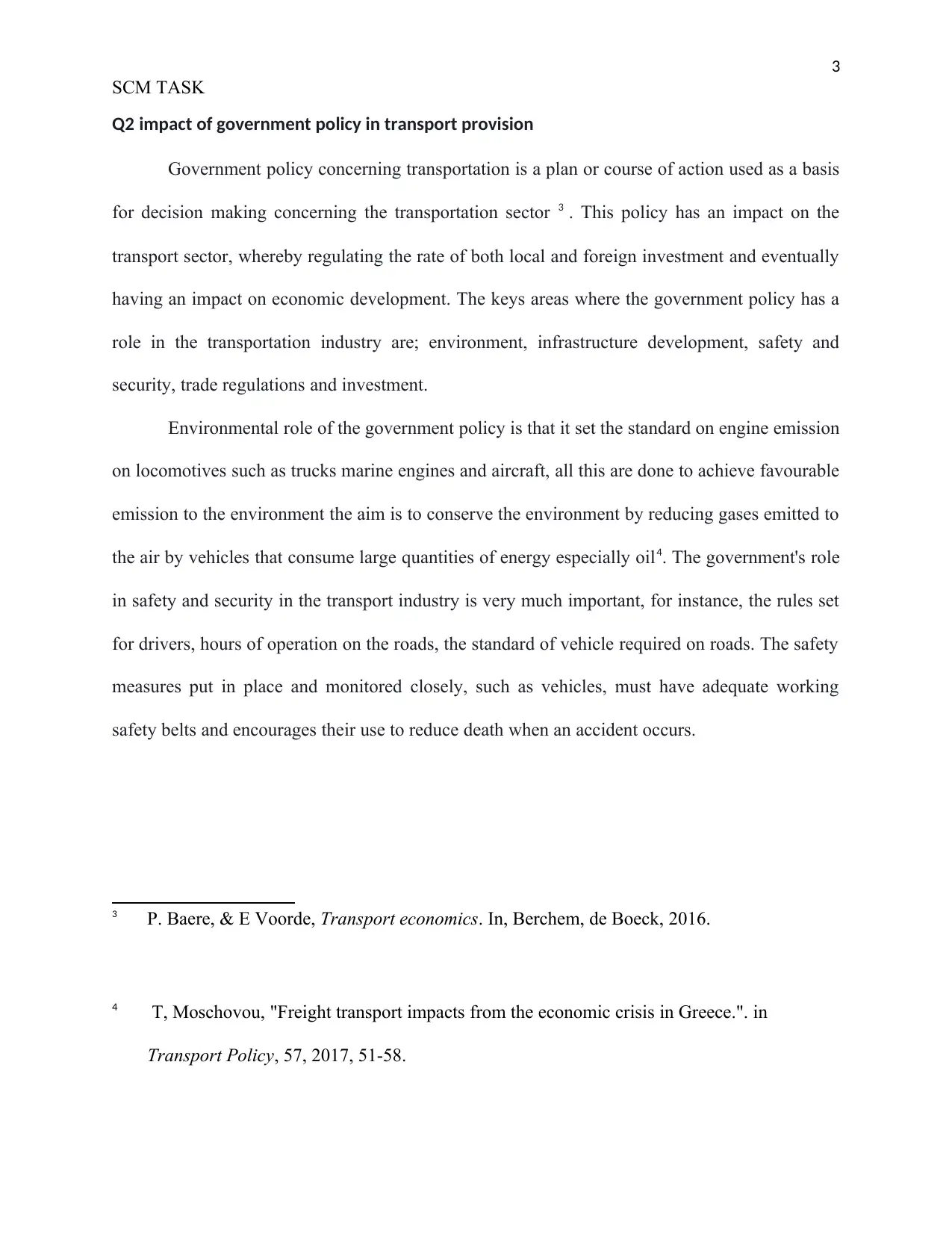
3
SCM TASK
Q2 impact of government policy in transport provision
Government policy concerning transportation is a plan or course of action used as a basis
for decision making concerning the transportation sector 3 . This policy has an impact on the
transport sector, whereby regulating the rate of both local and foreign investment and eventually
having an impact on economic development. The keys areas where the government policy has a
role in the transportation industry are; environment, infrastructure development, safety and
security, trade regulations and investment.
Environmental role of the government policy is that it set the standard on engine emission
on locomotives such as trucks marine engines and aircraft, all this are done to achieve favourable
emission to the environment the aim is to conserve the environment by reducing gases emitted to
the air by vehicles that consume large quantities of energy especially oil4. The government's role
in safety and security in the transport industry is very much important, for instance, the rules set
for drivers, hours of operation on the roads, the standard of vehicle required on roads. The safety
measures put in place and monitored closely, such as vehicles, must have adequate working
safety belts and encourages their use to reduce death when an accident occurs.
3 P. Baere, & E Voorde, Transport economics. In, Berchem, de Boeck, 2016.
4 T, Moschovou, "Freight transport impacts from the economic crisis in Greece.". in
Transport Policy, 57, 2017, 51-58.
SCM TASK
Q2 impact of government policy in transport provision
Government policy concerning transportation is a plan or course of action used as a basis
for decision making concerning the transportation sector 3 . This policy has an impact on the
transport sector, whereby regulating the rate of both local and foreign investment and eventually
having an impact on economic development. The keys areas where the government policy has a
role in the transportation industry are; environment, infrastructure development, safety and
security, trade regulations and investment.
Environmental role of the government policy is that it set the standard on engine emission
on locomotives such as trucks marine engines and aircraft, all this are done to achieve favourable
emission to the environment the aim is to conserve the environment by reducing gases emitted to
the air by vehicles that consume large quantities of energy especially oil4. The government's role
in safety and security in the transport industry is very much important, for instance, the rules set
for drivers, hours of operation on the roads, the standard of vehicle required on roads. The safety
measures put in place and monitored closely, such as vehicles, must have adequate working
safety belts and encourages their use to reduce death when an accident occurs.
3 P. Baere, & E Voorde, Transport economics. In, Berchem, de Boeck, 2016.
4 T, Moschovou, "Freight transport impacts from the economic crisis in Greece.". in
Transport Policy, 57, 2017, 51-58.
⊘ This is a preview!⊘
Do you want full access?
Subscribe today to unlock all pages.

Trusted by 1+ million students worldwide
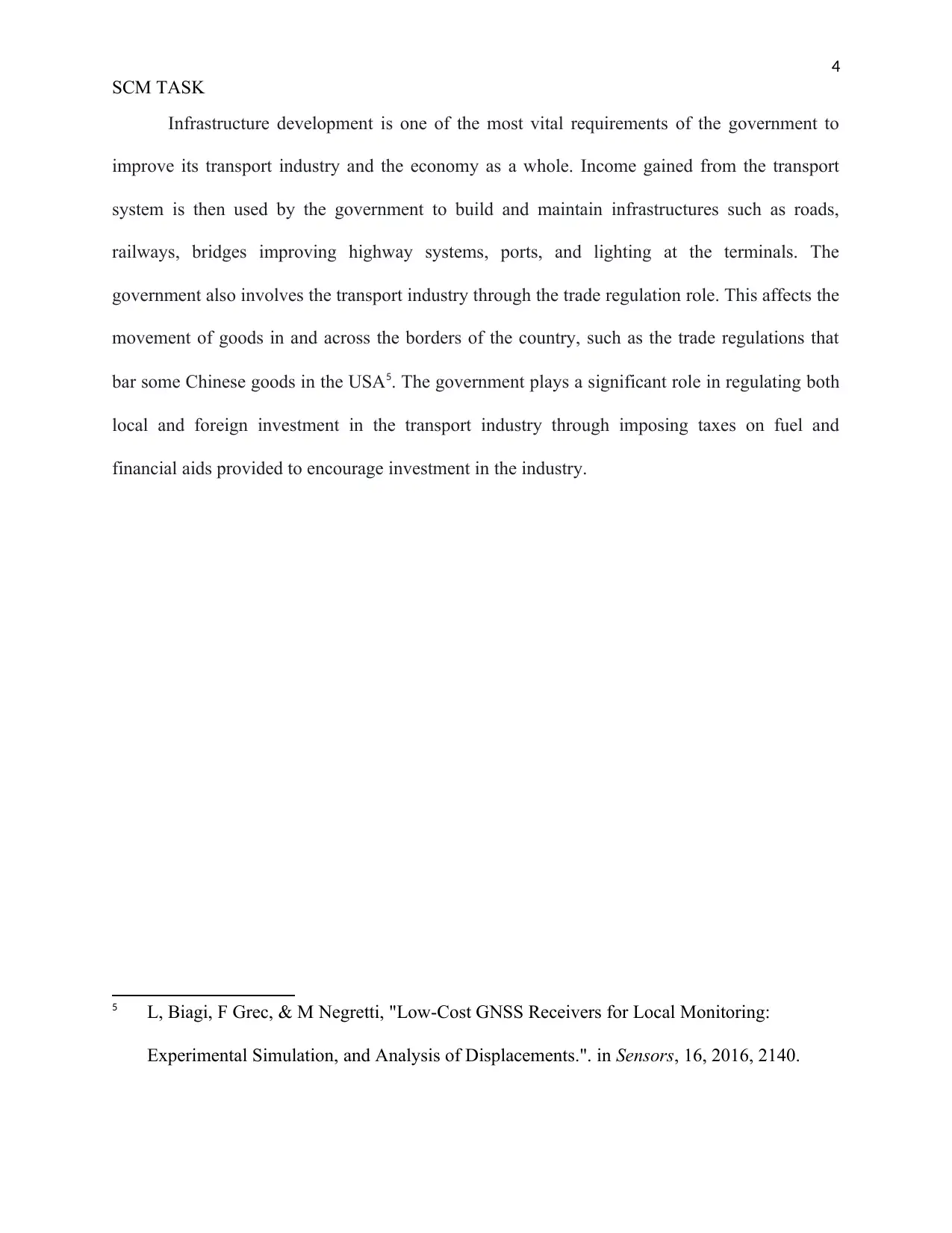
4
SCM TASK
Infrastructure development is one of the most vital requirements of the government to
improve its transport industry and the economy as a whole. Income gained from the transport
system is then used by the government to build and maintain infrastructures such as roads,
railways, bridges improving highway systems, ports, and lighting at the terminals. The
government also involves the transport industry through the trade regulation role. This affects the
movement of goods in and across the borders of the country, such as the trade regulations that
bar some Chinese goods in the USA5. The government plays a significant role in regulating both
local and foreign investment in the transport industry through imposing taxes on fuel and
financial aids provided to encourage investment in the industry.
5 L, Biagi, F Grec, & M Negretti, "Low-Cost GNSS Receivers for Local Monitoring:
Experimental Simulation, and Analysis of Displacements.". in Sensors, 16, 2016, 2140.
SCM TASK
Infrastructure development is one of the most vital requirements of the government to
improve its transport industry and the economy as a whole. Income gained from the transport
system is then used by the government to build and maintain infrastructures such as roads,
railways, bridges improving highway systems, ports, and lighting at the terminals. The
government also involves the transport industry through the trade regulation role. This affects the
movement of goods in and across the borders of the country, such as the trade regulations that
bar some Chinese goods in the USA5. The government plays a significant role in regulating both
local and foreign investment in the transport industry through imposing taxes on fuel and
financial aids provided to encourage investment in the industry.
5 L, Biagi, F Grec, & M Negretti, "Low-Cost GNSS Receivers for Local Monitoring:
Experimental Simulation, and Analysis of Displacements.". in Sensors, 16, 2016, 2140.
Paraphrase This Document
Need a fresh take? Get an instant paraphrase of this document with our AI Paraphraser
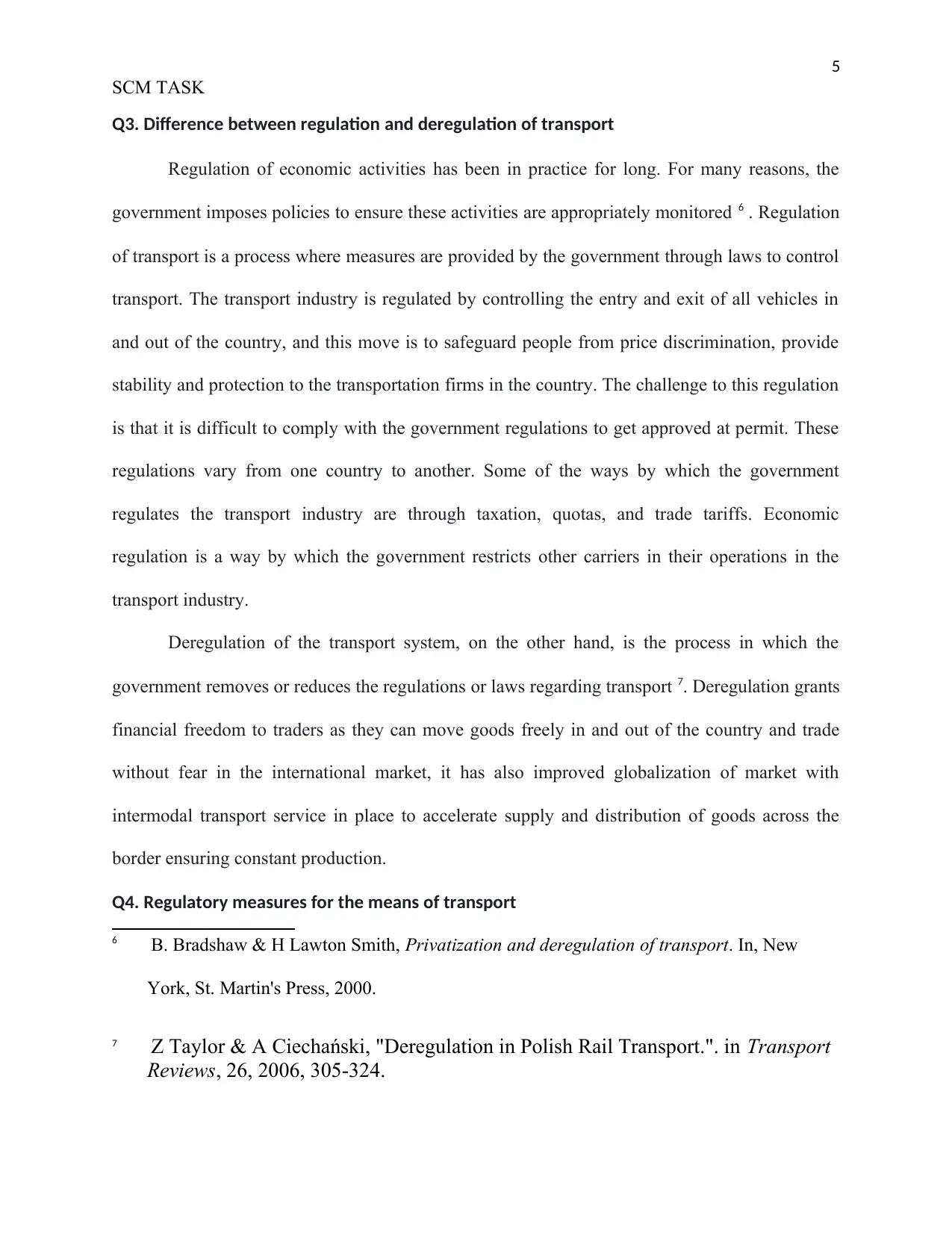
5
SCM TASK
Q3. Difference between regulation and deregulation of transport
Regulation of economic activities has been in practice for long. For many reasons, the
government imposes policies to ensure these activities are appropriately monitored 6 . Regulation
of transport is a process where measures are provided by the government through laws to control
transport. The transport industry is regulated by controlling the entry and exit of all vehicles in
and out of the country, and this move is to safeguard people from price discrimination, provide
stability and protection to the transportation firms in the country. The challenge to this regulation
is that it is difficult to comply with the government regulations to get approved at permit. These
regulations vary from one country to another. Some of the ways by which the government
regulates the transport industry are through taxation, quotas, and trade tariffs. Economic
regulation is a way by which the government restricts other carriers in their operations in the
transport industry.
Deregulation of the transport system, on the other hand, is the process in which the
government removes or reduces the regulations or laws regarding transport 7. Deregulation grants
financial freedom to traders as they can move goods freely in and out of the country and trade
without fear in the international market, it has also improved globalization of market with
intermodal transport service in place to accelerate supply and distribution of goods across the
border ensuring constant production.
Q4. Regulatory measures for the means of transport
6 B. Bradshaw & H Lawton Smith, Privatization and deregulation of transport. In, New
York, St. Martin's Press, 2000.
7 Z Taylor & A Ciechański, "Deregulation in Polish Rail Transport.". in Transport
Reviews, 26, 2006, 305-324.
SCM TASK
Q3. Difference between regulation and deregulation of transport
Regulation of economic activities has been in practice for long. For many reasons, the
government imposes policies to ensure these activities are appropriately monitored 6 . Regulation
of transport is a process where measures are provided by the government through laws to control
transport. The transport industry is regulated by controlling the entry and exit of all vehicles in
and out of the country, and this move is to safeguard people from price discrimination, provide
stability and protection to the transportation firms in the country. The challenge to this regulation
is that it is difficult to comply with the government regulations to get approved at permit. These
regulations vary from one country to another. Some of the ways by which the government
regulates the transport industry are through taxation, quotas, and trade tariffs. Economic
regulation is a way by which the government restricts other carriers in their operations in the
transport industry.
Deregulation of the transport system, on the other hand, is the process in which the
government removes or reduces the regulations or laws regarding transport 7. Deregulation grants
financial freedom to traders as they can move goods freely in and out of the country and trade
without fear in the international market, it has also improved globalization of market with
intermodal transport service in place to accelerate supply and distribution of goods across the
border ensuring constant production.
Q4. Regulatory measures for the means of transport
6 B. Bradshaw & H Lawton Smith, Privatization and deregulation of transport. In, New
York, St. Martin's Press, 2000.
7 Z Taylor & A Ciechański, "Deregulation in Polish Rail Transport.". in Transport
Reviews, 26, 2006, 305-324.
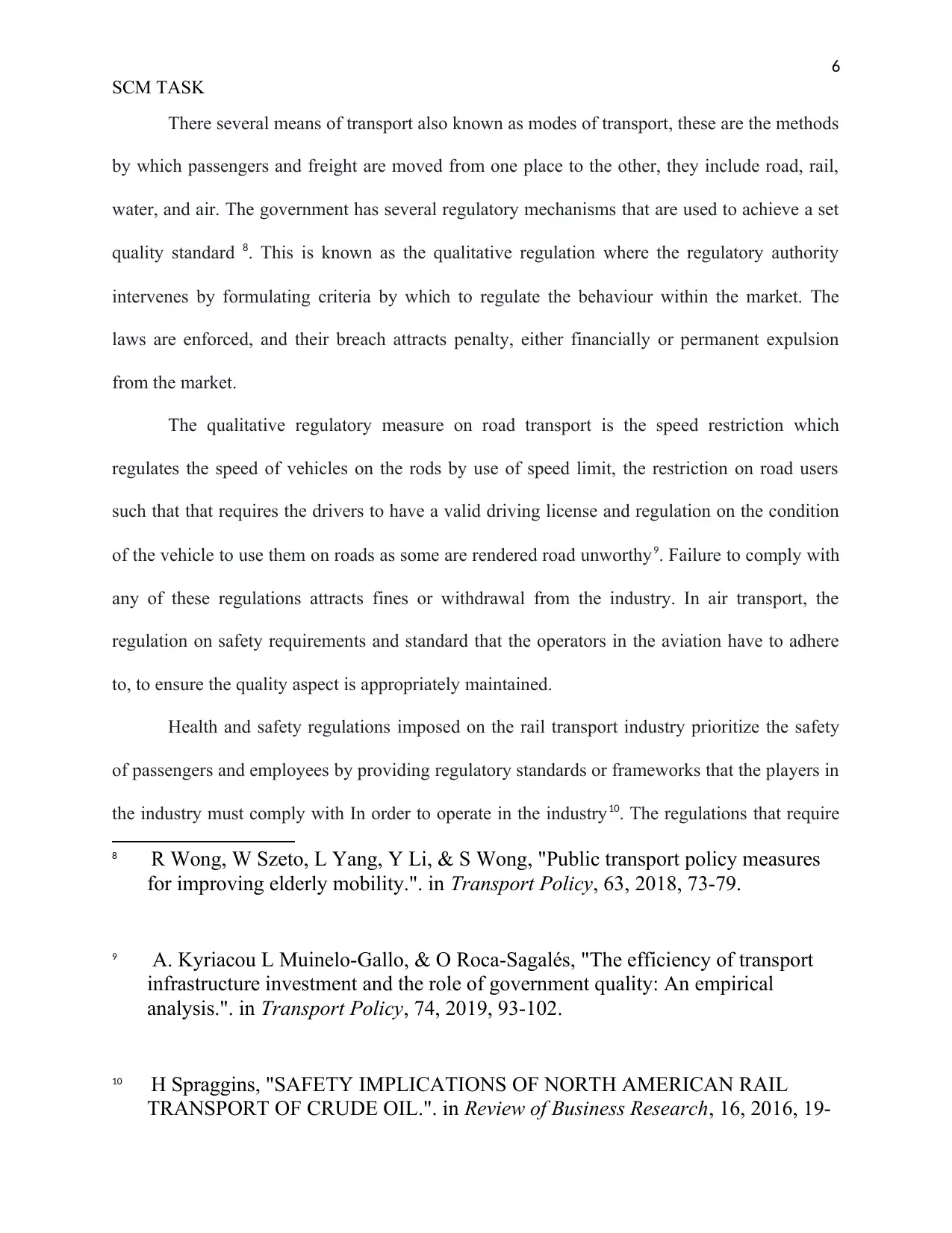
6
SCM TASK
There several means of transport also known as modes of transport, these are the methods
by which passengers and freight are moved from one place to the other, they include road, rail,
water, and air. The government has several regulatory mechanisms that are used to achieve a set
quality standard 8. This is known as the qualitative regulation where the regulatory authority
intervenes by formulating criteria by which to regulate the behaviour within the market. The
laws are enforced, and their breach attracts penalty, either financially or permanent expulsion
from the market.
The qualitative regulatory measure on road transport is the speed restriction which
regulates the speed of vehicles on the rods by use of speed limit, the restriction on road users
such that that requires the drivers to have a valid driving license and regulation on the condition
of the vehicle to use them on roads as some are rendered road unworthy9. Failure to comply with
any of these regulations attracts fines or withdrawal from the industry. In air transport, the
regulation on safety requirements and standard that the operators in the aviation have to adhere
to, to ensure the quality aspect is appropriately maintained.
Health and safety regulations imposed on the rail transport industry prioritize the safety
of passengers and employees by providing regulatory standards or frameworks that the players in
the industry must comply with In order to operate in the industry10. The regulations that require
8 R Wong, W Szeto, L Yang, Y Li, & S Wong, "Public transport policy measures
for improving elderly mobility.". in Transport Policy, 63, 2018, 73-79.
9 A. Kyriacou L Muinelo-Gallo, & O Roca-Sagalés, "The efficiency of transport
infrastructure investment and the role of government quality: An empirical
analysis.". in Transport Policy, 74, 2019, 93-102.
10 H Spraggins, "SAFETY IMPLICATIONS OF NORTH AMERICAN RAIL
TRANSPORT OF CRUDE OIL.". in Review of Business Research, 16, 2016, 19-
SCM TASK
There several means of transport also known as modes of transport, these are the methods
by which passengers and freight are moved from one place to the other, they include road, rail,
water, and air. The government has several regulatory mechanisms that are used to achieve a set
quality standard 8. This is known as the qualitative regulation where the regulatory authority
intervenes by formulating criteria by which to regulate the behaviour within the market. The
laws are enforced, and their breach attracts penalty, either financially or permanent expulsion
from the market.
The qualitative regulatory measure on road transport is the speed restriction which
regulates the speed of vehicles on the rods by use of speed limit, the restriction on road users
such that that requires the drivers to have a valid driving license and regulation on the condition
of the vehicle to use them on roads as some are rendered road unworthy9. Failure to comply with
any of these regulations attracts fines or withdrawal from the industry. In air transport, the
regulation on safety requirements and standard that the operators in the aviation have to adhere
to, to ensure the quality aspect is appropriately maintained.
Health and safety regulations imposed on the rail transport industry prioritize the safety
of passengers and employees by providing regulatory standards or frameworks that the players in
the industry must comply with In order to operate in the industry10. The regulations that require
8 R Wong, W Szeto, L Yang, Y Li, & S Wong, "Public transport policy measures
for improving elderly mobility.". in Transport Policy, 63, 2018, 73-79.
9 A. Kyriacou L Muinelo-Gallo, & O Roca-Sagalés, "The efficiency of transport
infrastructure investment and the role of government quality: An empirical
analysis.". in Transport Policy, 74, 2019, 93-102.
10 H Spraggins, "SAFETY IMPLICATIONS OF NORTH AMERICAN RAIL
TRANSPORT OF CRUDE OIL.". in Review of Business Research, 16, 2016, 19-
⊘ This is a preview!⊘
Do you want full access?
Subscribe today to unlock all pages.

Trusted by 1+ million students worldwide
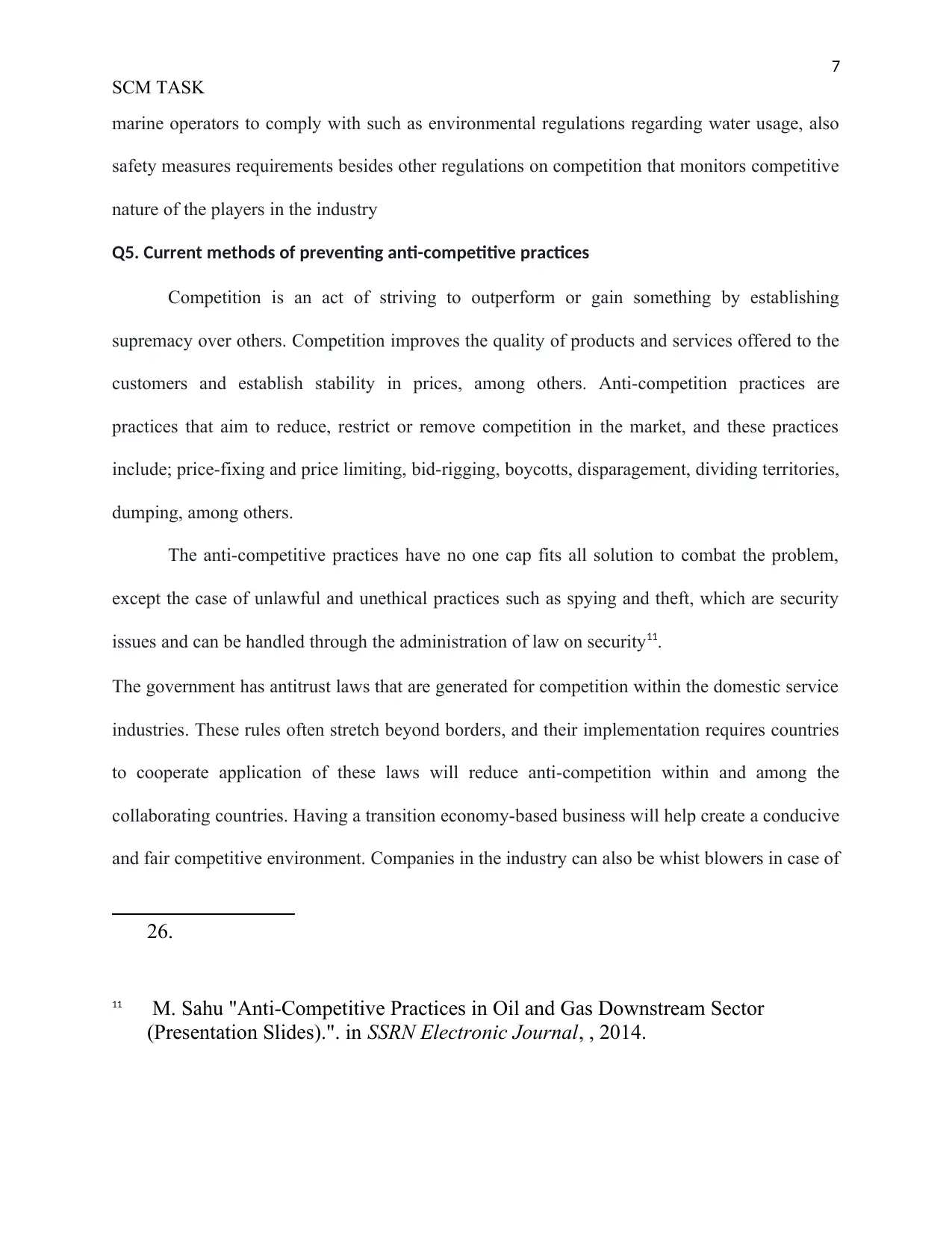
7
SCM TASK
marine operators to comply with such as environmental regulations regarding water usage, also
safety measures requirements besides other regulations on competition that monitors competitive
nature of the players in the industry
Q5. Current methods of preventing anti-competitive practices
Competition is an act of striving to outperform or gain something by establishing
supremacy over others. Competition improves the quality of products and services offered to the
customers and establish stability in prices, among others. Anti-competition practices are
practices that aim to reduce, restrict or remove competition in the market, and these practices
include; price-fixing and price limiting, bid-rigging, boycotts, disparagement, dividing territories,
dumping, among others.
The anti-competitive practices have no one cap fits all solution to combat the problem,
except the case of unlawful and unethical practices such as spying and theft, which are security
issues and can be handled through the administration of law on security11.
The government has antitrust laws that are generated for competition within the domestic service
industries. These rules often stretch beyond borders, and their implementation requires countries
to cooperate application of these laws will reduce anti-competition within and among the
collaborating countries. Having a transition economy-based business will help create a conducive
and fair competitive environment. Companies in the industry can also be whist blowers in case of
26.
11 M. Sahu "Anti-Competitive Practices in Oil and Gas Downstream Sector
(Presentation Slides).". in SSRN Electronic Journal, , 2014.
SCM TASK
marine operators to comply with such as environmental regulations regarding water usage, also
safety measures requirements besides other regulations on competition that monitors competitive
nature of the players in the industry
Q5. Current methods of preventing anti-competitive practices
Competition is an act of striving to outperform or gain something by establishing
supremacy over others. Competition improves the quality of products and services offered to the
customers and establish stability in prices, among others. Anti-competition practices are
practices that aim to reduce, restrict or remove competition in the market, and these practices
include; price-fixing and price limiting, bid-rigging, boycotts, disparagement, dividing territories,
dumping, among others.
The anti-competitive practices have no one cap fits all solution to combat the problem,
except the case of unlawful and unethical practices such as spying and theft, which are security
issues and can be handled through the administration of law on security11.
The government has antitrust laws that are generated for competition within the domestic service
industries. These rules often stretch beyond borders, and their implementation requires countries
to cooperate application of these laws will reduce anti-competition within and among the
collaborating countries. Having a transition economy-based business will help create a conducive
and fair competitive environment. Companies in the industry can also be whist blowers in case of
26.
11 M. Sahu "Anti-Competitive Practices in Oil and Gas Downstream Sector
(Presentation Slides).". in SSRN Electronic Journal, , 2014.
Paraphrase This Document
Need a fresh take? Get an instant paraphrase of this document with our AI Paraphraser
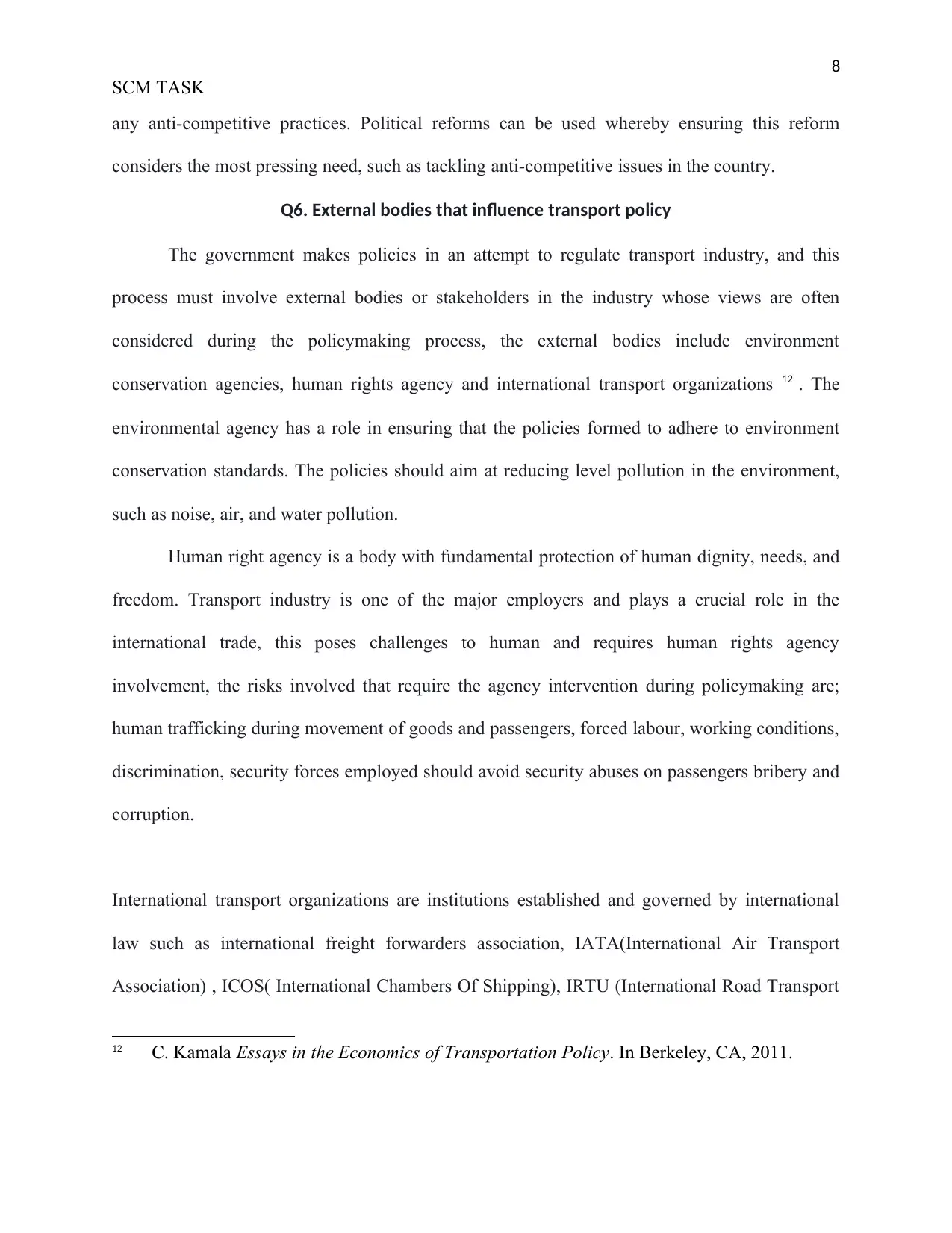
8
SCM TASK
any anti-competitive practices. Political reforms can be used whereby ensuring this reform
considers the most pressing need, such as tackling anti-competitive issues in the country.
Q6. External bodies that influence transport policy
The government makes policies in an attempt to regulate transport industry, and this
process must involve external bodies or stakeholders in the industry whose views are often
considered during the policymaking process, the external bodies include environment
conservation agencies, human rights agency and international transport organizations 12 . The
environmental agency has a role in ensuring that the policies formed to adhere to environment
conservation standards. The policies should aim at reducing level pollution in the environment,
such as noise, air, and water pollution.
Human right agency is a body with fundamental protection of human dignity, needs, and
freedom. Transport industry is one of the major employers and plays a crucial role in the
international trade, this poses challenges to human and requires human rights agency
involvement, the risks involved that require the agency intervention during policymaking are;
human trafficking during movement of goods and passengers, forced labour, working conditions,
discrimination, security forces employed should avoid security abuses on passengers bribery and
corruption.
International transport organizations are institutions established and governed by international
law such as international freight forwarders association, IATA(International Air Transport
Association) , ICOS( International Chambers Of Shipping), IRTU (International Road Transport
12 C. Kamala Essays in the Economics of Transportation Policy. In Berkeley, CA, 2011.
SCM TASK
any anti-competitive practices. Political reforms can be used whereby ensuring this reform
considers the most pressing need, such as tackling anti-competitive issues in the country.
Q6. External bodies that influence transport policy
The government makes policies in an attempt to regulate transport industry, and this
process must involve external bodies or stakeholders in the industry whose views are often
considered during the policymaking process, the external bodies include environment
conservation agencies, human rights agency and international transport organizations 12 . The
environmental agency has a role in ensuring that the policies formed to adhere to environment
conservation standards. The policies should aim at reducing level pollution in the environment,
such as noise, air, and water pollution.
Human right agency is a body with fundamental protection of human dignity, needs, and
freedom. Transport industry is one of the major employers and plays a crucial role in the
international trade, this poses challenges to human and requires human rights agency
involvement, the risks involved that require the agency intervention during policymaking are;
human trafficking during movement of goods and passengers, forced labour, working conditions,
discrimination, security forces employed should avoid security abuses on passengers bribery and
corruption.
International transport organizations are institutions established and governed by international
law such as international freight forwarders association, IATA(International Air Transport
Association) , ICOS( International Chambers Of Shipping), IRTU (International Road Transport
12 C. Kamala Essays in the Economics of Transportation Policy. In Berkeley, CA, 2011.
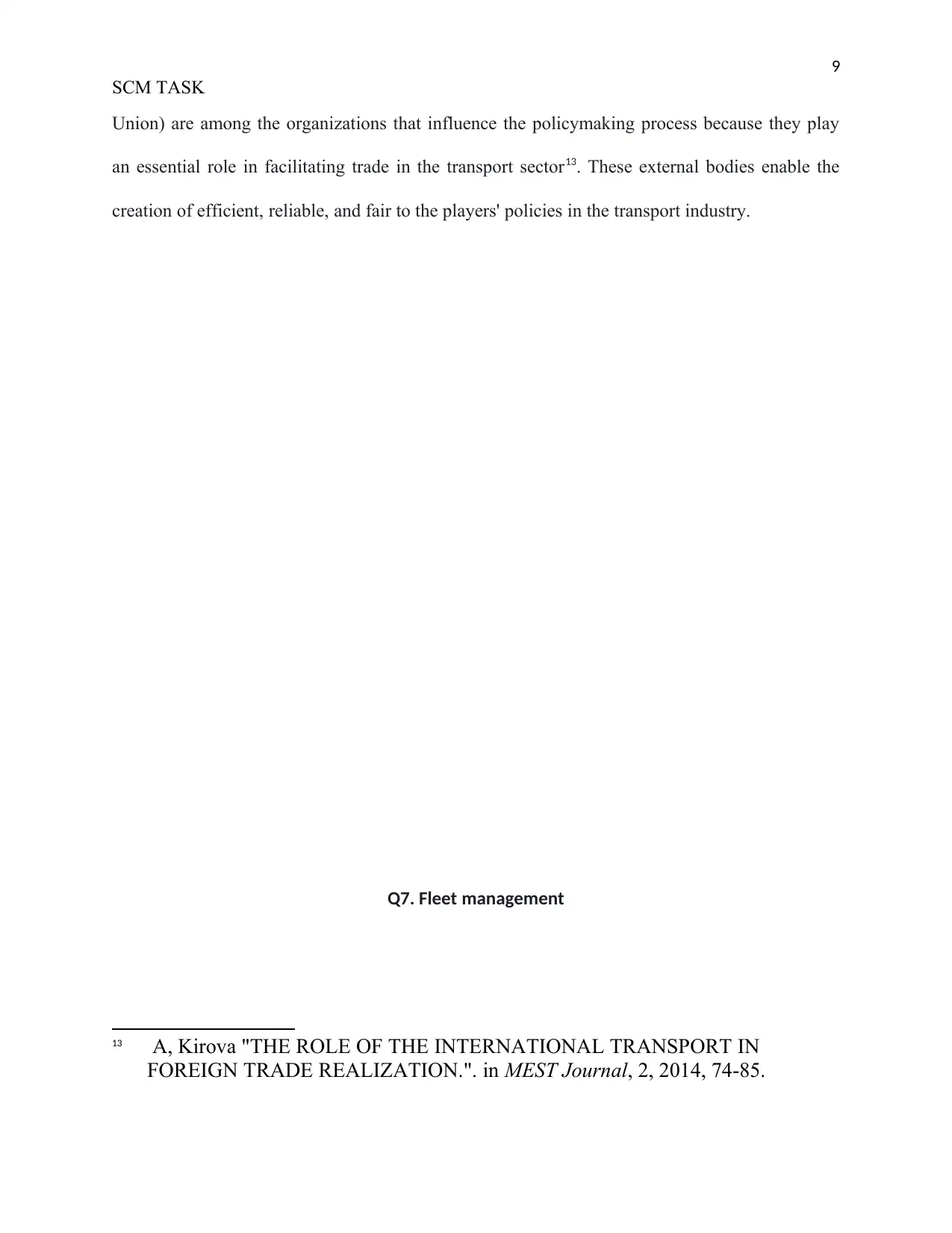
9
SCM TASK
Union) are among the organizations that influence the policymaking process because they play
an essential role in facilitating trade in the transport sector13. These external bodies enable the
creation of efficient, reliable, and fair to the players' policies in the transport industry.
Q7. Fleet management
13 A, Kirova "THE ROLE OF THE INTERNATIONAL TRANSPORT IN
FOREIGN TRADE REALIZATION.". in MEST Journal, 2, 2014, 74-85.
SCM TASK
Union) are among the organizations that influence the policymaking process because they play
an essential role in facilitating trade in the transport sector13. These external bodies enable the
creation of efficient, reliable, and fair to the players' policies in the transport industry.
Q7. Fleet management
13 A, Kirova "THE ROLE OF THE INTERNATIONAL TRANSPORT IN
FOREIGN TRADE REALIZATION.". in MEST Journal, 2, 2014, 74-85.
⊘ This is a preview!⊘
Do you want full access?
Subscribe today to unlock all pages.

Trusted by 1+ million students worldwide
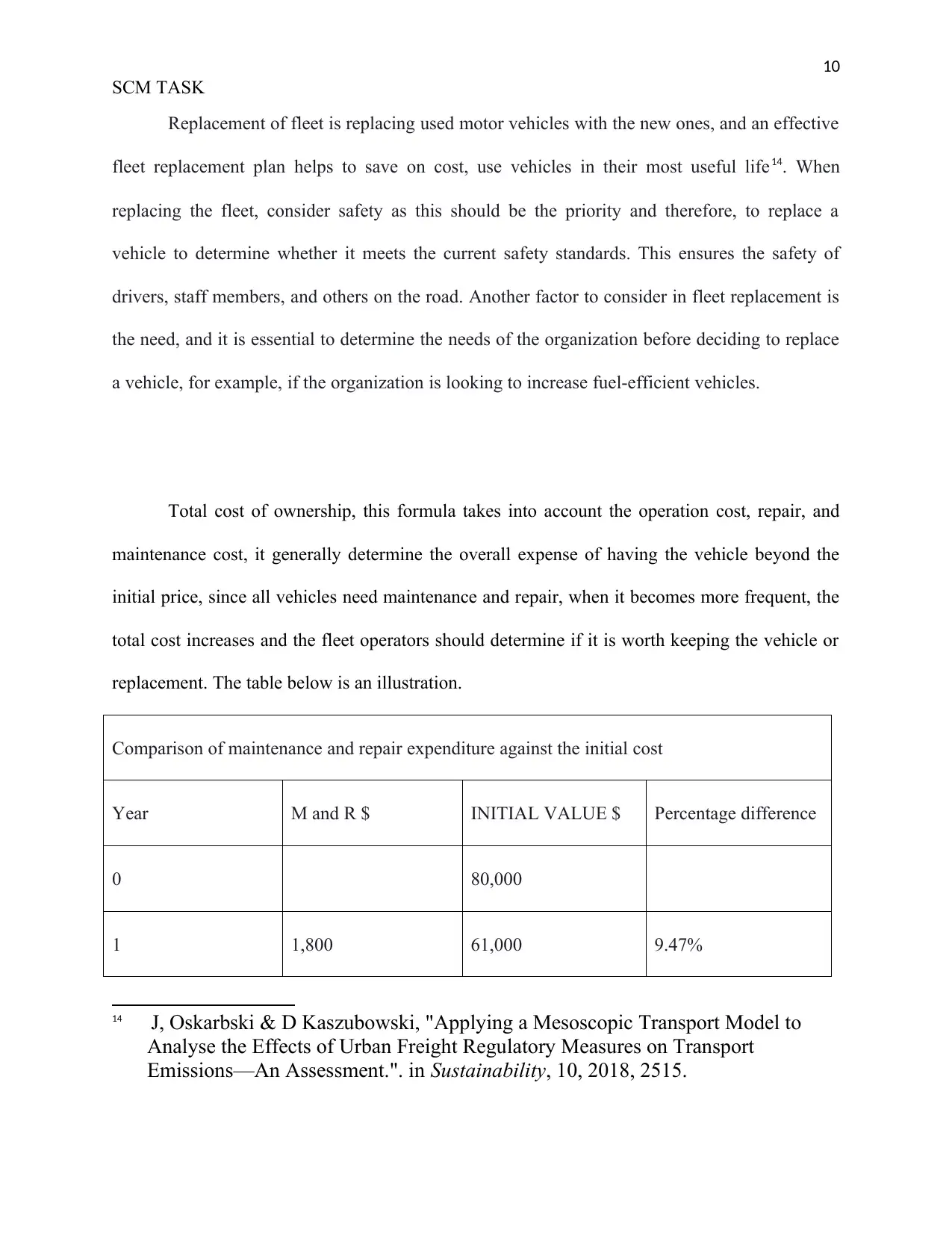
10
SCM TASK
Replacement of fleet is replacing used motor vehicles with the new ones, and an effective
fleet replacement plan helps to save on cost, use vehicles in their most useful life14. When
replacing the fleet, consider safety as this should be the priority and therefore, to replace a
vehicle to determine whether it meets the current safety standards. This ensures the safety of
drivers, staff members, and others on the road. Another factor to consider in fleet replacement is
the need, and it is essential to determine the needs of the organization before deciding to replace
a vehicle, for example, if the organization is looking to increase fuel-efficient vehicles.
Total cost of ownership, this formula takes into account the operation cost, repair, and
maintenance cost, it generally determine the overall expense of having the vehicle beyond the
initial price, since all vehicles need maintenance and repair, when it becomes more frequent, the
total cost increases and the fleet operators should determine if it is worth keeping the vehicle or
replacement. The table below is an illustration.
Comparison of maintenance and repair expenditure against the initial cost
Year M and R $ INITIAL VALUE $ Percentage difference
0 80,000
1 1,800 61,000 9.47%
14 J, Oskarbski & D Kaszubowski, "Applying a Mesoscopic Transport Model to
Analyse the Effects of Urban Freight Regulatory Measures on Transport
Emissions—An Assessment.". in Sustainability, 10, 2018, 2515.
SCM TASK
Replacement of fleet is replacing used motor vehicles with the new ones, and an effective
fleet replacement plan helps to save on cost, use vehicles in their most useful life14. When
replacing the fleet, consider safety as this should be the priority and therefore, to replace a
vehicle to determine whether it meets the current safety standards. This ensures the safety of
drivers, staff members, and others on the road. Another factor to consider in fleet replacement is
the need, and it is essential to determine the needs of the organization before deciding to replace
a vehicle, for example, if the organization is looking to increase fuel-efficient vehicles.
Total cost of ownership, this formula takes into account the operation cost, repair, and
maintenance cost, it generally determine the overall expense of having the vehicle beyond the
initial price, since all vehicles need maintenance and repair, when it becomes more frequent, the
total cost increases and the fleet operators should determine if it is worth keeping the vehicle or
replacement. The table below is an illustration.
Comparison of maintenance and repair expenditure against the initial cost
Year M and R $ INITIAL VALUE $ Percentage difference
0 80,000
1 1,800 61,000 9.47%
14 J, Oskarbski & D Kaszubowski, "Applying a Mesoscopic Transport Model to
Analyse the Effects of Urban Freight Regulatory Measures on Transport
Emissions—An Assessment.". in Sustainability, 10, 2018, 2515.
Paraphrase This Document
Need a fresh take? Get an instant paraphrase of this document with our AI Paraphraser
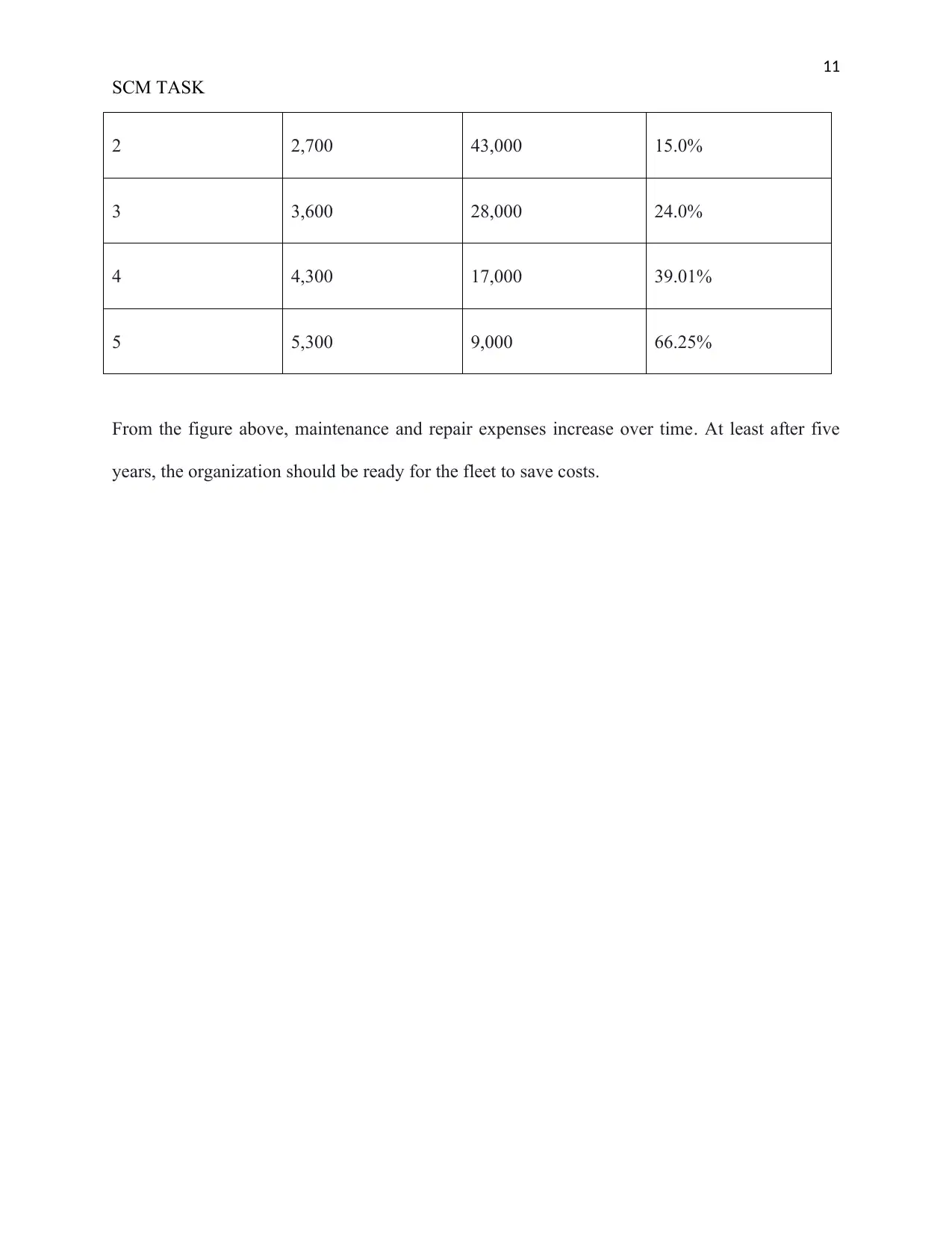
11
SCM TASK
2 2,700 43,000 15.0%
3 3,600 28,000 24.0%
4 4,300 17,000 39.01%
5 5,300 9,000 66.25%
From the figure above, maintenance and repair expenses increase over time. At least after five
years, the organization should be ready for the fleet to save costs.
SCM TASK
2 2,700 43,000 15.0%
3 3,600 28,000 24.0%
4 4,300 17,000 39.01%
5 5,300 9,000 66.25%
From the figure above, maintenance and repair expenses increase over time. At least after five
years, the organization should be ready for the fleet to save costs.
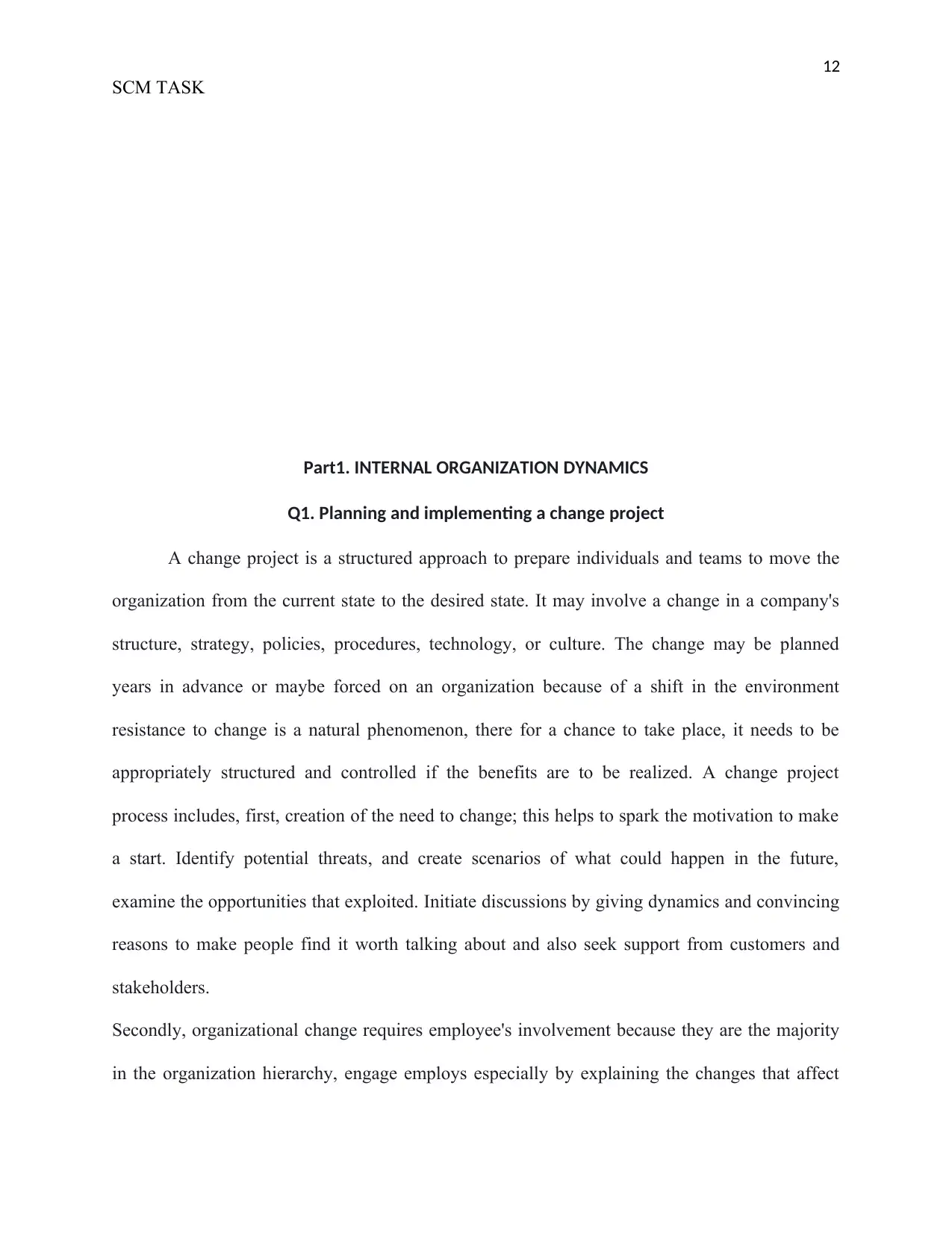
12
SCM TASK
Part1. INTERNAL ORGANIZATION DYNAMICS
Q1. Planning and implementing a change project
A change project is a structured approach to prepare individuals and teams to move the
organization from the current state to the desired state. It may involve a change in a company's
structure, strategy, policies, procedures, technology, or culture. The change may be planned
years in advance or maybe forced on an organization because of a shift in the environment
resistance to change is a natural phenomenon, there for a chance to take place, it needs to be
appropriately structured and controlled if the benefits are to be realized. A change project
process includes, first, creation of the need to change; this helps to spark the motivation to make
a start. Identify potential threats, and create scenarios of what could happen in the future,
examine the opportunities that exploited. Initiate discussions by giving dynamics and convincing
reasons to make people find it worth talking about and also seek support from customers and
stakeholders.
Secondly, organizational change requires employee's involvement because they are the majority
in the organization hierarchy, engage employs especially by explaining the changes that affect
SCM TASK
Part1. INTERNAL ORGANIZATION DYNAMICS
Q1. Planning and implementing a change project
A change project is a structured approach to prepare individuals and teams to move the
organization from the current state to the desired state. It may involve a change in a company's
structure, strategy, policies, procedures, technology, or culture. The change may be planned
years in advance or maybe forced on an organization because of a shift in the environment
resistance to change is a natural phenomenon, there for a chance to take place, it needs to be
appropriately structured and controlled if the benefits are to be realized. A change project
process includes, first, creation of the need to change; this helps to spark the motivation to make
a start. Identify potential threats, and create scenarios of what could happen in the future,
examine the opportunities that exploited. Initiate discussions by giving dynamics and convincing
reasons to make people find it worth talking about and also seek support from customers and
stakeholders.
Secondly, organizational change requires employee's involvement because they are the majority
in the organization hierarchy, engage employs especially by explaining the changes that affect
⊘ This is a preview!⊘
Do you want full access?
Subscribe today to unlock all pages.

Trusted by 1+ million students worldwide
1 out of 36
Related Documents
Your All-in-One AI-Powered Toolkit for Academic Success.
+13062052269
info@desklib.com
Available 24*7 on WhatsApp / Email
![[object Object]](/_next/static/media/star-bottom.7253800d.svg)
Unlock your academic potential
Copyright © 2020–2025 A2Z Services. All Rights Reserved. Developed and managed by ZUCOL.





